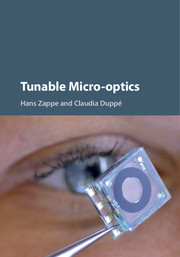Book contents
- Frontmatter
- Dedication
- Contents
- List of contributors
- List of acronyms
- Part I Introduction
- Part II Devices and materials
- 3 Soft-Matter Micro-optics
- 4 Tunable Reflective Optics
- 5 Tunable Liquid Lenses
- 6 Optofluidic Micro-shutters and Micro-irises
- 7 Solid Body Elastomeric Lenses
- 8 Spatially Tunable Polarization Devices
- 9 Aluminum Nitride and Diamond Membranes for Tunable Micro-optics
- 10 Piezoelectrically Actuated Tunable Microlenses
- Part III Systems and Applications
- Index
- References
9 - Aluminum Nitride and Diamond Membranes for Tunable Micro-optics
from Part II - Devices and materials
Published online by Cambridge University Press: 05 December 2015
- Frontmatter
- Dedication
- Contents
- List of contributors
- List of acronyms
- Part I Introduction
- Part II Devices and materials
- 3 Soft-Matter Micro-optics
- 4 Tunable Reflective Optics
- 5 Tunable Liquid Lenses
- 6 Optofluidic Micro-shutters and Micro-irises
- 7 Solid Body Elastomeric Lenses
- 8 Spatially Tunable Polarization Devices
- 9 Aluminum Nitride and Diamond Membranes for Tunable Micro-optics
- 10 Piezoelectrically Actuated Tunable Microlenses
- Part III Systems and Applications
- Index
- References
Summary
Introduction
Flexible membranes are the most frequently used components to conceive optical elements with tunable optical functionality, that is tunable micro-optical elements. They can be deformed actively by a variety of techniques, such as hydraulic pressure and thermo-mechanic or piezo-electric actuation. The optical tuning range of the resulting components depends on the amount of deformation generated during the actuation. Next to the optical quality of the membrane material, the strength of the deforming forces as well as the elasticity of the membranes are crucial parameters for the performance of tunable micro-optics. One of the most critical tasks when designing tunable optical elements is the trade-off between stability and tunability of the optical element. Stability is needed to achieve good, reliable, and reproducible optical performance. Elasticity and nonplastic deformation is required to achieve easy and reproducible tuning over a wide tuning range. In order to fulfil the requirements of both, the appropriate choice of material is of utmost importance for the performance of tunable micro-optical components. In this chapter, we discuss nanocrystalline solid materials (such as aluminum nitride, AlN or nanocrystalline diamond, NCD layers) in detail as these represent an excellent basis for tunable optical membranes. These nanocrystalline materials show good optical uniformity and transparency over a broad spectral range. A tailor-made microtechnological process guarantees thin layers that are only a few 100 nm thick. In consequence, the membranes made of the new material possess mechanical properties that are ideally suited for tunable components and offer new perspectives for the development of optical elements and systems.
In this chapter, we will chiefly focus on the processing, performance, and specific material properties of nanocrystalline AlN and NCD membranes. Many of the optical design issues related to the application of such membrane devices in complex optical microsystems for imaging performance will be reported in Chapter 15, “Adaptive Scanning Micro-eye.” To begin with, we will discuss some basic considerations with regard to the optical performance of spherically and non-spherically deformed membrane systems. Some of the performances here have only become possible thanks to the new material properties available by using nanocrystalline solid membranes. In Section 9.3 we address the processing and material characteristics of AlN membranes. We will specifically address the exciting mechanical properties that become feasible, as well as the performance under thermomechanical actuation. NCD membranes will thus be the focus of Section 9.4.
- Type
- Chapter
- Information
- Tunable Micro-optics , pp. 219 - 240Publisher: Cambridge University PressPrint publication year: 2015
References
- 1
- Cited by

